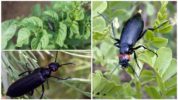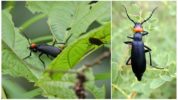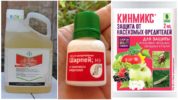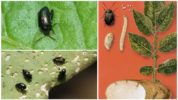- Blackhead
- Blackhead
- Poison Against Potato Pests
- Potato flea
The last decade, many gardeners complain about the appearance of black beetles on the potato plantings, which greatly damage the tops and destroy the bushes. Information on how such insects are called and how to deal with black bugs on potatoes will be of interest to everyone who cares about getting a good harvest.
How to determine the type of bug
Potato beds are invaded by many pestsamong which the first place rightfully belongs colorado beetles. However, besides him, there are other insects that can harm the bushes and fruits of potatoes.
On a note!
The appearance of black beetles in Russia was recorded in the regions of Siberia and Buryatia, where they were able to inflict considerable damage on agricultural fields occupied by potatoes. And quite successfully attacked the beds in the garden plots.
According to experts, dark insects that settle on the potato tops and feed on it can be of 2 different types:
- blackhead - a representative of winged insects belonging to the family Meloinae (lat.), Which are garden pests;
- small potato flea beetles - relate to leaf beetle family (lat. Chrysomelidae), attack the planting of legumes, vegetables and melons.
Therefore, when you see black beetles on the potato in the garden, you must first determine exactly what kind it is and apply appropriate control measures to it.
Shpanka black-headed: photo and description
The adult individual bunny has a size of 12 to 22 mm, the black color of the body, and the head is painted red, black eyes and mouth are located on it. On the top of the head there is a dark strip with white hairs, a mustache - black with a red tip. The wings have a characteristic white border, consisting of white villi.
On a note!
The popular name of the beetle is "spaniard fly".

The main diet of pests is the green parts of wild and garden plants. Settling in the beds, the bunny eats potato leaves, young shoots and even flowers, using powerful chewing blades. Scientists consider these bugs to be companions locusts, since their appearance on garden crops often happens after their invasion. Dangles are parasites whose larvae develop in the capsules of orthoptera insects (locusts).
Pests begin to fly in late May and continue an active lifestyle until early August, especially a lot of them are found on hot days. They easily move between forest and park plantings, choosing the right tasty lunch on the way for themselves. After finding one, they sit on the branches of a fodder plant (lilac, poplar, vegetable crops) and gnaw the leaves.
During the flight, the black potato beetle emits a pungent, unpleasant odor. In the evening and at night, beetles are in a state of rest - they sit motionless and wait for the morning. The life expectancy of the pest is 2-4 months.
The reproduction of the bobbins is as follows: the female makes egg laying in minks dug in the ground at a shallow depth (up to 2.8 cm), 40-50 elongated yellow testicles up to 6.5 mm in size.Then he tamps the soil. The process of egg development lasts 23-38 days.
Then from them bright brown flat larvae (tringulins) with long white legs appear. With their help, they are actively looking for egg capsules with orthoptera eggs (locusts, etc.), which can last up to 2 weeks. Then they settle and eat within their 4-10 days. As the larva develops, it goes through several stages of growth. Having exterminated all the eggs, she gnaws a hole and crawls into the soil, where the molting stage goes. The larva turns into a false orange chrysalis with a hard shell and short legs.
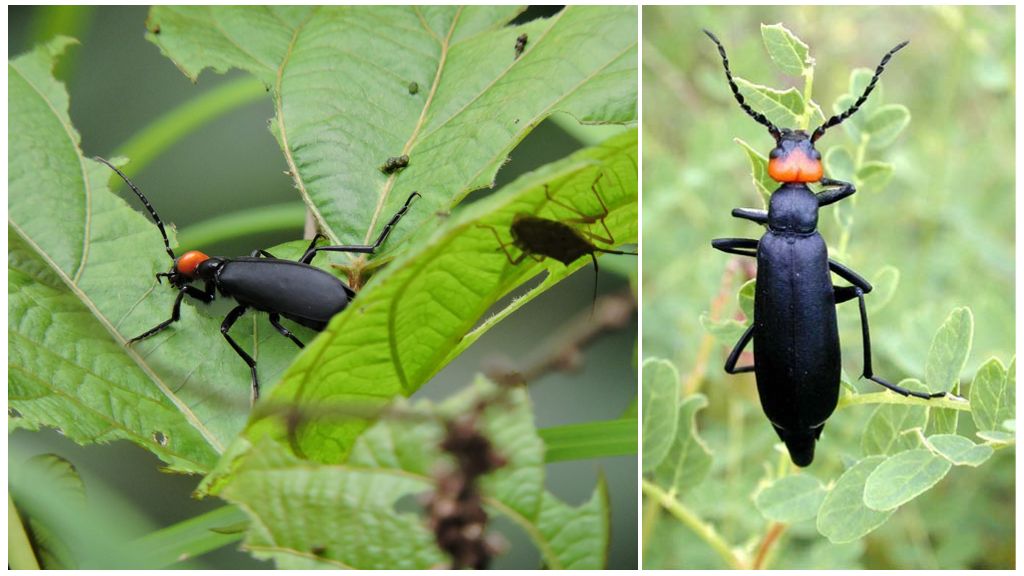
With the onset of cold weather, the larvae of the bobbin begin to dig into the ground to a depth of 40 cm, they survive the wintering in the stage of the false pupa. By April, they begin to get closer to the surface of the earth and pupate.
The distribution area in Russia falls on the regions of the Far East (Amur Region, Primorsky Territory, Altai and Transbaikalia), as well as in Asian countries (Japan, Korea, China and Mongolia).
On a note!
However, in recent years, due to changes in the climate, black-headed rabbit has begun to appear in the regions of the European part of Russia - it was discovered by gardeners in the Middle and Lower Volga region, South-Western Siberia, etc.
Potato and human harm
The insect black casserole eats potatoes, as well as beets and some other types of garden crops. It is a typical garden pest, which, when mass attacked on crops, can cause great harm to plants (potatoes, beets, legumes). Young seedlings, exposed to active pest foliage, start to hurt and can even dry out. After gnawing potato tops with beetles, yield from the bush decreases markedly. If you do not take action, then in 2-3 days the pests are able to eat a potato bush, leaving a lone stem sticking out.
Important!
The black-headed shpanka is also a poisonous insect. At the slightest danger, the beetle releases yellow blood from the joints on its paws - a toxic liquid that helps to defend itself from enemies. Its main component is cantharidin - a substance that can cause painful abscesses on the surface of the skin of living organisms, which gradually turn into watery ulcers and blisters, and in humans it contributes to the development of cystitis.
How to process potatoes from bacon
In order to save potato plants, you need to know what to do if a black beetle attacks a potato. There are 2 main ways to deal with bobbin: manual collection and processing of pesticides.
Many people prefer to collect pests manually, which is recommended in the morning, even before sunrise. However, this environmentally friendly method is dangerous because of the toxic substance secreted by the beetles, therefore, they must be collected with gloves on.
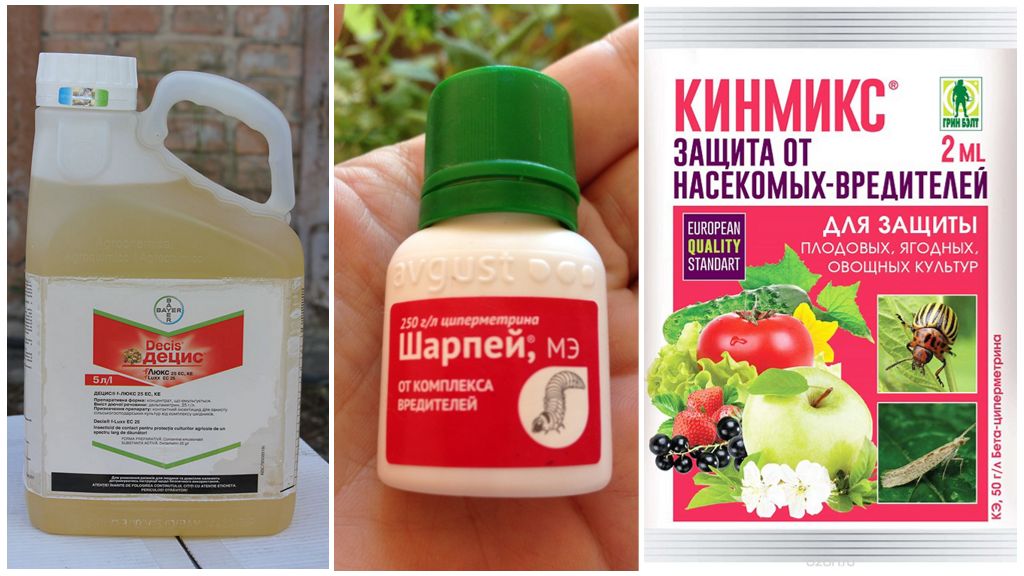
On a note!
The manual method is suitable only for a small area of the garden. An additional measure is the extermination of laid eggs and larvae, for which deep weeding and loosening of the soil are used.
With a large garden area, the only salvation from the invasion of such pests is the use of strong chemicals:
- Decis-pros - concentrated insecticide of contact-intestinal action in the form of granules, refers to synthetic pyrethroid preparations, is effective against insect pests (Lepidoptera, Coleoptera and Equine-winged), which affect garden crops; sold in bottles of 600 g or sachets of 1 g;
- Shar Pei is a water-soluble emulsion, designed to protect vegetable, garden and cereal crops, flowers from gnawing and sucking pests, has a contact-intestinal effect on their eggs, larvae and imago; the main active ingredient is cypermethrin; before use, the emulsion is diluted with water according to the instructions;
- Kinmix - a concentrated emulsion in ampoules, belongs to the class of moderately dangerous drugs, acts on the nervous system of insects, entering through the intestines and the outer cover; contains beta cypermethrin;
- Karate - effective in the processing of potatoes and other vegetable crops, is available in the form of a suspension containing microcapsules (water-soluble), etc.
Important!
Experts recommend spraying potato beds in the evening or in the morning, at temperatures up to + 25 ° C or on a cloudy day (no rain). On hot days, a chemical treatment can cause burns on the leaves. The wind speed during processing should be minimal (up to 2 m / s).
Potato flea
Small black bugs on potatoes - potato fleas (lat. Epitrix tuberis) are also pests of planting vegetables in the garden. Outwardly, they look like small bugs up to 2.8 mm in size. Fleas are of American origin, they were first discovered in Colorado and Nebraska, and then migrated to neighboring states and other states. In Russia, pests are common in many regions and even reached the Primorsky Territory.
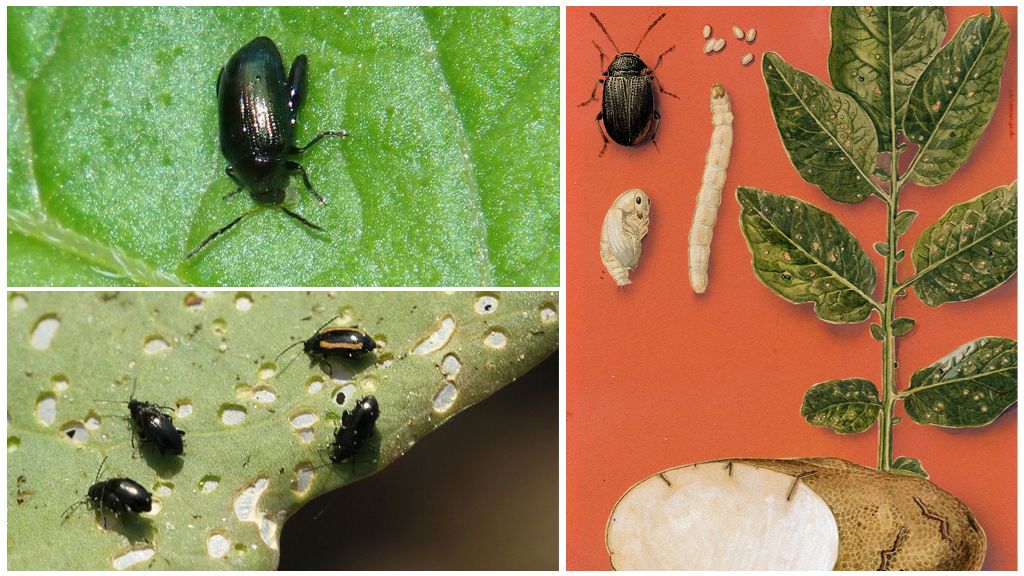
The main food of the pest is the leaves of potatoes, and in its absence, the fleas go to other nightshade crops (tomatoes, eggplant, etc.). Occasionally, leaves are eaten on legumes, cucumbers, carrots and beets, on pumpkins and even weeds.
Fleas develop in 2 generations per year. Females lay eggs (size up to 0.7 mm) under the ground to a depth of 6-8 cm in an amount of up to 180 pcs. in year. From eggs appear quite large larvae of white color, cylindrical in shape up to 12 mm long. They feed on small potato roots, which has a negative effect on the quality of the fruit.
Adult beetles winter in the soil and come to the surface in spring (March-May). They begin to fly in search of plants for food, and are able to cover fairly large distances.
Having settled on a potato, pests gnaw at its leaves, making hollows or holes up to 1.5 mm in size. If the damage is large, then the sheet looks like a sieve. Potato fleas and their larvae can transmit various infections to plants. In order not to apply measures for the treatment of plants, it is necessary to carry out the destruction of bugs in time.
Potato flea control
If small black insects appeared on potatoes (leaves and flowers), then only chemical insecticides (Confidor, Bizkaia, Decis, Calypso, Spark, Alatar etc.), since it is difficult to assemble them manually because of the smallest size.
To get rid of black bugs on potatoes, it is necessary to carry out protective measures:
- regularly weed in which fleas settle and lay eggs;
- plant early varieties of potatoes
As can be seen from the above information, there are several types of insect pests of potatoes. Correct identification of the type of beetles will help in time to take measures to save potato beds and get a good crop of root crops.
